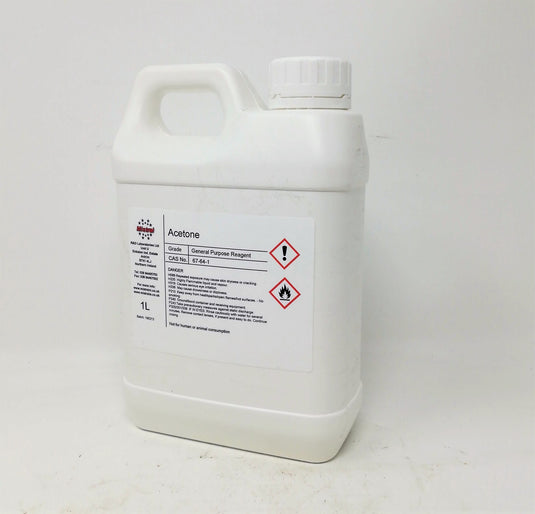Acetone
General Reagent Grade
Acetone is a clear, colourless, low-boiling, flammable and volatile liquid characterized by rapid evaporation and a faintly aromatic odour. It readily mixes with most organic solvents and mixes completely with water. However, compatibility should be checked prior to mixing with other solvents or materials.
PROPERTIES OF ACETONE:
- Synonyms: B-ketopropane, dimethyl ketone, dimethylformaldehyde, DMK, propanone, 2-propanone, propan-2-one
- CAS NO: 67-64-1
- Appearance: clear liquid
- Colour: <5 pt-co="" li="">
- Distillation BP: 56.2oC
- Melting point: -94.9oC
- Flash Point: -20oC
- Autoignition temperature: 465oC
- Assay: 99.5 % Min
- Water: 0.1% max
- Non volatile residue: 20 ppm max
- Acidity as acetic acid: 20 ppm max
- Permanganate fading time: 90 minutes min
Applications for Acetone:
- Nail varnish remover
- Nail extension remover
- Laboratory reagent
- Paint remover formulations
- Solvent
- Cleaner & Degreaser
Acetone is used as a denaturation agent in denatured alcohol. In the laboratory, acetone is used as a solvent in a variety of organic reactions , such as SN2 reactions. The use of acetone solvent is also critical for the Jones oxidation. It is a common solvent for rinsing laboratory glassware because of its low cost, volatility, and ability to dissolve water. For similar reasons, acetone is also used as a drying agent. Acetone can be cooled with dry ice to -78 oC without freezing; acetone/dry ice baths are commonly used to conduct reactions at low temperatures. Acetone is fluorescent under ultraviolet light, and acetone vapor may be used as a fluorescent tracer in fluid flow experiments.
Acetone is often the primary component in cleaning agents such as nail polish remover. Acetone is a component of superglue remover and it easily removes residues from glass and porcelain.
Acetone is a good solvent that is a component of some paints and varnishes, as well as for most plastics and synthetic fibres. It is ideal for thinning fiberglass resin, cleaning fiberglass tools and dissolving two-part epoxies and superglue before hardening. A heavy-duty degreaser, it is useful in the preparation of metal prior to painting; it also thins polyester resins, vinyl and adhesives.
Acetone can also dissolve many plastics, including those used in Nalgene bottles made of polystyrene, polycarbonate and some types of polypropylene.
Many millions of kilograms of acetone are consumed in the production of the solvents methyl isobutyl alcohol and methyl isobutyl ketone. These products arise to give diacetone alcohol.
2 (CH3)2CO(CH3)2C(OH)CH2C(O)CH3
It can be used as an artistic agent; when rubbed on the back of a laser print or photocopy placed face-down on another surface and burnished firmly, the toner of the image is allowed to transfer to the destination surface. Some automotive enthusiasts add acetone at around 1 part in 500 to their fuel, following claims of dramatic improvement in fuel economy and engine life.
This practice is controversial as the body of systematic testing shows that acetone has no measurable effect or may in fact reduce engine life by adversely affecting fuel system parts.
Health & Safety:
F; R11; Xi; R36; R66; R67
EUH066: Repeated exposure may cause skin dryness or cracking. H225: Highly Flammable liquid and vapour. H319: Causes serious eye irritation. H336: May cause drowsiness or dizziness.
PLEASE NOTE: This product is not for human or animal consumption.
